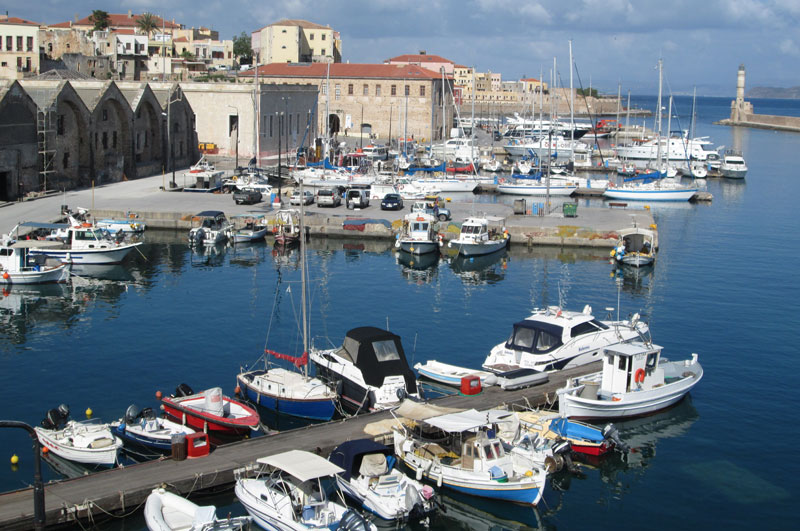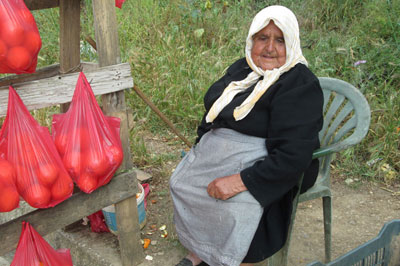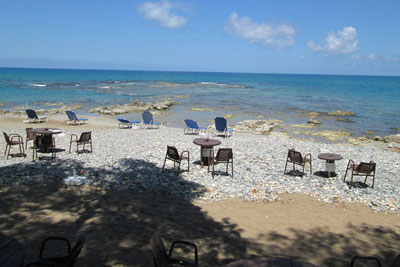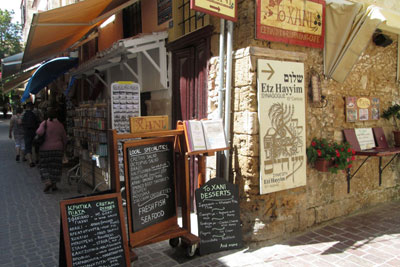An end-of-tour excursion brings to life the history of ancient Crete
This article appears on page 22 of the February 2015 issue.
My husband, John, and I, relying heavily on Tripadvisor.com and on DK Eyewitness Travel’s “Top 10 Crete,” visited Crete May 2-7, 2014, as the final leg of an independent tour of Greece. The people were friendly, the food was delicious, and we discovered that you don’t need a translator to get around.
An introduction
We arrived in the evening at the port in the city of Heraklion after a short, comfortable trip from Santorini on the Flying Cat 4 (phone +30 2810 346185, www.ferries.gr), which we had booked pre-trip for $198 for two in business class.
The only shipboard quirk was that the crew grabbed our luggage as we boarded without giving us receipts or showing us where it was located, which caused us some worries. However, there was no problem retrieving the luggage upon disembarking.
We stayed at the top-rated GDM Megaron (9, D. Beaufort Street; www.gdmmegaron.gr), wonderfully located for exploring Old Town Heraklion and the major city attractions. Our luxury double room with balcony (booked through Hotels.com) overlooked the harbor and cost €180 ($221) per night, including an outstanding buffet breakfast and free parking.
In the morning, we walked along the historic waterfront to the Historical Museum of Crete (€6 per person, including audio guide). The museum offered a very good overview of Crete’s complicated history involving Minoans, Arabs, Venetians, Ottomans and modern Greeks, all of whom have left their mark on the island.
Island attractions
On Crete, striking ruins, fortresses, harbors, mosques and Greek Orthodox churches abound. That afternoon we took a bus, found at the conveniently located bus station next to our hotel, for a short ride through Heraklion (€3 per person) to the ancient Minoan ruins at Knossos.
Inside the entrance to the site, registered guides were available to conduct tours. We decided to join several other visitors for a tour (€10 per person) rather than take a more expensive private tour.
The tour, which lasted over an hour, was an excellent (and really necessary) way to understand the ruins. It required walking on unpaved and uneven surfaces and would be challenging for those with mobility problems.
Back in town, the Heraklion Archaeological Museum merited two visits, the first time (€4 each) to see the amazing wall paintings from Knossos and the second time because the museum had just opened numerous additional galleries of fabulous antiquities after seven years of renovations (and raised the price to €6 each).
As in other museums in Greece, there were many knowledgeable guards/helpers who happily answered questions, and signs were in English as well as Greek. Also as at other museums and attractions in Greece, the senior discount rate applied only to citizens of the EU.
Amazingly, at this and several other museums we visited, many priceless exhibits were not behind any barriers. It’s hard to resist reaching out and touching the artifacts. (In fact, one guard told us that just before we came in, a child had put a soda can on the ancient sarcophagus in the middle of the exhibit room!)
We found that scheduled hours at some museums, attractions and bus stops in Greece were “flexible.” Check before you go.
There were numerous restaurants in the Old Town area. Ouzeri tou Terzaki (17 Marineli; www.terzakhs.gr) offered well-made Cretan specialties as well as more traditional Greek dishes in a cozy atmosphere with prompt service (€35 for two for dinner). At this restaurant, as well as at most others we went to in Greece, patrons were graciously offered a free dessert, often delicious Greek yogurt with local honey, and/or small glasses of raki, a fiery Greek liquor.
Hitting the road
We explored more of Crete driving a standard-shift rental car from Caravel (phone +30 2810 245345, www.caravel.gr), arranged through our hotel at a cost of €150 for three days, including full insurance coverage (but no AC). Gas was not included, and it was a mistake to fill the tank ($90), as we used only half (great mileage). We were given no reimbursement for the gas we left in the tank on return.
Driving west from Heraklion along the well-paved new National Road, we reached Chania, Crete’s second-largest city, in about two hours. It was easy to follow the route, since important signs were posted in English right after the signs in Greek. However, despite having GPS, we had a hard time getting to our hotel, Porto Veneziano, in Old Town Chania, as many “streets” were, in fact, pedestrian paths. If you go, get detailed directions from the hotel.
Porto Veneziano (Akti Enoseos & Glafkou; www.portoveneziano.gr) was an excellent hotel on the Old Venetian Harbor. We paid €159 for our one-night stay, including a wonderful buffet breakfast and free parking (a nice plus in Chania) for a top-floor suite facing the picture-postcard ancient harbor. (We were upgraded to a superior suite.)
The hotel was at the quiet end of the waterfront, within easy walking distance of attractions, restaurants and shopping. Our stroll along the harbor took us past fishermen repairing their nets and others selling sea sponges that they had just harvested.
As usual in Greece, many museums were closed on Monday. We went to the small but lovely Etz Hayyim Synagogue, the only operating synagogue on Crete. (Most of the Jewish population was killed during WWII.) We were fortunate that a staff member was there to tell us about the congregation and the synagogue’s history.
We were disappointed in Chania’s Central Market, as there was very little there. Shopping in the nearby streets was more rewarding.
Crete’s well-known leather products were in full display in the traditional shops. We stopped at a shop that sold locally made sandals, and the shopkeeper showed us old photographs of her father, who had crafted beautiful boots and sandals totally by hand. It would be unusual to find such attention to detail in the mass-marketed goods of today.
Rethymno
Driving back to Heraklion, we spent a few hours in Rethymno. We were able to park near the Fortezza, the old Venetian fortress, and we walked through the Old Town and around the base of the enormous fortress.
The Old Town was a confusing maze, but we found the Historical & Folklore Museum (€4 each) a short time before it closed for the day. It was very small but had excellent coverage of much of the traditional culture of Crete: farming, sheep raising, fishing, weaving, leatherworking, basket and pottery making, olive oil production, winemaking and silk production.
Cretan women pride themselves on their baking, and the intricate designs on wedding-feast breads were amazing. Of course, today, Crete relies heavily on tourism.
Leaving the Old Town, we drove through the newer areas of Rethymno and past numerous beaches. Back on the highway, we stopped at one of the many huts run by elderly folk in traditional village garb selling bags of oranges (there are lots of citrus farms on Crete).
May brings wildflowers to Crete, and we saw thousands of beautiful blooms along the National Road. We also saw what appeared to be decorated boxes on posts, which we later learned were memorials for the many victims of motor-vehicle accidents (mostly motorcyclists).
A final day
On our last day in Crete, we drove east on the old National Road from the Megaron Hotel past the beach town of Hersonissos, turning onto the beach road to the Lychnostatis Open Air Museum (phone +30 28970 23660, www.lychnostatis.gr). We very much enjoyed seeing the traditional Cretan buildings brought together at this site, learning about Cretan crafts and seeing indigenous plants (entry, €7 per person).
The back of the property opens to a beach and the sea, so we were able to get a feel for that aspect of Crete as well.
We had decided that we would not drive into the steep, forbidding mountains (which cover most of the middle of central and western Crete) to see the mountain villages, since the roads were questionable. Instead, we drove to a typical Cretan town, Archanes, located very close to Knossos. The road led past numerous farms and vineyards.
We spent the remainder of the day in Heraklion, then taxied to the airport the next morning (€13), flying back to the US by way of Athens and Amsterdam, as there were no nonstop flights between the US and Greece.
I recommend adding Crete to your trip list.




